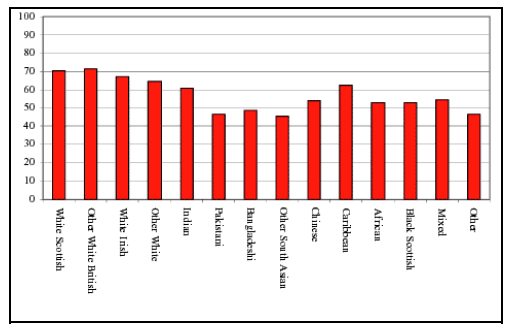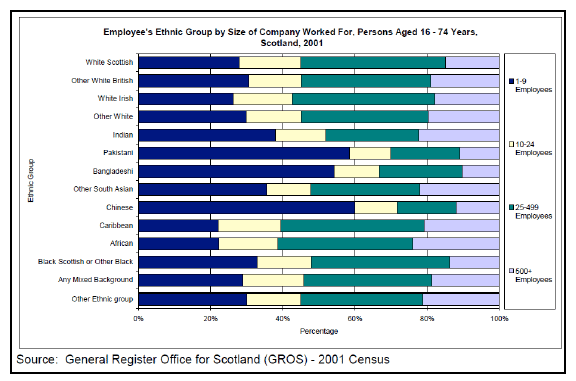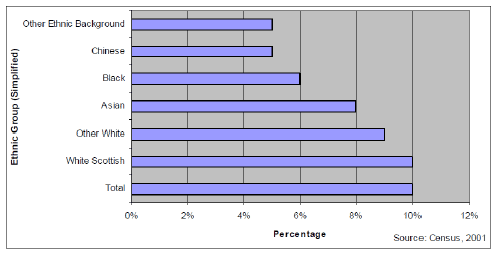Scottish Government Equality Outcomes: Ethnicity Evidence Review
This evidence review was prepared to support the production of the Scottish Government's Equality Outcomes, with regard to ethnicity.
5 Employment
5.1 This section considers variations in employment rates, sectoral patterns, self-employment, pay gaps, and unpaid care work.
5.2 By way of introduction, people who are socially excluded in employment terms are also disproportionately likely to experience poor physical and mental health34. Accordingly, the Joseph Rowntree Foundation considers that combating social exclusion through pro-employment policies can prove an important factor in improving living conditions and opportunities for people of working age and also their children, given the tendency for poverty and social exclusion to be transmitted across generations35.
Employment rates
5.3 In 2011 in Scotland, the employment rate for people from all ethnic minority groups combined was 61.7%36. This compares to an overall employment rate of 70.7%.
5.4 Figure 5 gives a snapshot of employment rates for individual ethnic groups at the time of the 2001 census37.
Figure 5: Employment rate by ethnic group, 2001 (Source: Scottish Government, Analysis of Ethnicity in the 2001 Census).

5.5 The Joseph Rowntree Foundation paper, Poverty and Ethnicity in Scotland (2011)38, reports that employment rates are high among A8 migrants and particularly low among Pakistanis and Bangladeshis, especially women. It combines the visible minority ethnic groups together into a 'non-white' category, to show that overall, white households tend to show more contrast than non-white ones: in white households, the adults are more likely to either all be working or to have no one in work, whereas in non-white households it was more likely that there would be a mix of working and non-working adults. Relatively few non-white households contain no one of working age (1.5% vs 15.4% for white households), and most (85.6 %) contain two or more adults of working age. However, only a third have all adults in employment, compared with 43.6% of white households. At the same time, only one-fifth of non-white households have all adults unemployed or inactive, compared with 28.5% of white households. Nearly half of non-white households (46%) have a mixture of employed and unemployed or inactive members, compared with only 27.8% of white households.
5.6 In terms of employment trends, The Position of Scotland's Equality Groups39 reports that between 2004 and 2007 the employment rate (16-64) for ethnic minorities increased each year - see Table 5. However, subsequent reductions in the rate through 2008 and 2009 saw it fall back to a similar level to 2005. Between 2009 and 2010, the rate has risen by 0.5 percentage points to 58.3%. The drop in rates for ethnic minorities between 2007 and 2009 (65.9% to 57.8%) was greater than the drop in employment rate for all people aged 16-64 (73.8% to 71.9%): the report suggests that employment rates for ethnic minorities were more affected by the recession.
Table 5: Employment Rate for Ethnic Minorities, Scotland, 2004-2010 (Source: The Position of Scotland's Equality Groups, 2011)
| Proportion | Level | |
|---|---|---|
| 2004 | 55.3% | 42,800 |
| 2005 | 57.8% | 49,200 |
| 2006 | 60.0% | 56,800 |
| 2007 | 65.9% | 66,300 |
| 2008 | 61.2% | 61,300 |
| 2009 | 57.8% | 68,300 |
| 2010 | 58.3% | 72,300 |
Source: Annual Population Survey (Jan-Dec), ONS
5.7 The EHRC's Review of Research40 observes that ethnic minorities' lower economic activity and employment rates in Scotland have not been fully explained by the currently available evidence. Without data on the reasons for economic inactivity, it is difficult to draw firm conclusions about the explanations for this. One possible explanation relates to the relatively high rates of participation in education associated with the relative youth of the working-age ethnic minority population in Scotland. However, without further analysis of the broader picture on economic inactivity, notably on the range of reasons for higher levels of economic inactivity by ethnic minority groups, it is not possible to understand the potential explanations for this trend fully.
Sectoral patterns
5.8 The Annual Population Survey (2007-08) data show that people from ethnic minority backgrounds are more likely to work in distribution, hotels and restaurants than those from a white background. Ethnic minorities are less likely to work in manufacturing, but the proportions working with public administration, education and health are broadly similar. For occupational groupings, it also appears from this survey that ethnic minority people are more likely to be within the 'Professional Occupations', 'Associate and Professional' and 'Sales and Customer Service' occupations than their white counterparts.
Self-employment
5.9 The EHRC Review of Research finds that self-employment plays an important part in the labour market participation of ethnic minority groups, and cites a 2005 study using data from the 2001 Census show that ethnic minority business owners account for just over 3% of all self-employment in Scotland41. The self-employment rate is highest for Pakistani (32%), Chinese (23%) and Indian (22%) groups. Bangladeshi and other South Asian groups also have high rates of self-employment (20% for both groups). In contrast, self-employment rates are substantially lower for white Scottish (10%), Caribbean (10%) and African (8%) people42. Deakins et al conclude that, on current trends, the relative importance of ethnic minority businesses to Scotland's economy will continue to increase due to the younger demographic profile of the ethnic minority population.
5.10 Summary figures for self-employment are given in:
- The Scottish Government's (2012)43 analysis of data from the Annual Population Survey observed that self-employment rates tend to be higher for people from ethnic minority groups. In 2010, the self-employment rate for people from an ethnic minority group was 14.0%, compared to 10.8% for those of white ethnic origin.
- The Joseph Rowntree paper, Poverty and Ethnicity in Scotland, reports that self-employment was high (in 2011)44 among the visible ethnic minority communities and Gypsy/Travellers, but low among A8 migrants.
- The Scottish Household Survey (cited by Netto, 2010). Data from 2003-06 show that people from an Asian background are more likely to be self-employed: 25% of Asians, compared to 12% of white people and 11% of other groups.
5.11 The High Level Summary of Equality Statistics45 plots the ethnicity of employees against the size of firm they work for (see Figure 6). In 2001, 60% of Chinese adults and 58% of Pakistani adults worked in organisations employing 9 people or less (micro-businesses) compared with 28% of white Scottish adults. Seventy-two percent of Chinese adults, 69% of Pakistani adults and 67% of Bangladeshi adults worked in 'small' businesses employing 24 people or less. 'Large' businesses with 500 or more employees, employed 24% of African adults, and 22% of Indian adults and other South Asian adults.
Figure 6: Employee ethnicity and size of employing firm (Source: High Level Summary of Equality Statistics, 2006)

Pay gaps
5.12 EHRC research from 200846 suggests that, although educational attainment may be viewed as a route out of poverty, this may not translate into advantages in the job market. Certain ethnic groups receive lower pay than others, a finding that cannot be accounted for in terms of educational qualifications alone: data from the Labour Force Survey (over three years from October 2004) show pay gaps that could not be attributed to factors such as qualifications and occupational class. For instance, while white British Jewish men were predicted to earn 24 % more than white British Christian men, Pakistani and Bangladeshi Muslim men respectively earned 13 and 21 % less than white British Christian men.
5.13 In Pay Gaps Across the Equality Strands47 (2009), the EHRC reports that pay gaps in the UK vary substantially by ethnic group and gender. For men, most - but not all - of the major UK ethnic minority groups have lower average pay than white men. However, once personal characteristics (such as culture, class, education and age) have been controlled for, all major ethnic minority groups have lower pay. For women the picture is more mixed, with some ethnic minorities earning more than white women, whether or not personal characteristics are controlled for. The Pay Gaps report observes that there are major ethnic differences in participation rates, in unemployment, in qualifications and occupation, with most of the larger ethnic minority groups substantially disadvantaged.
5.14 The EHRC research from 2008 gives 2004-07 data on unadjusted hourly pay gaps for the major UK ethnic groups shows substantial variation by ethnic group. Compared with white British men, Indian men have a slightly positive pay gap (meaning that they are paid more) and black Caribbean men have a slightly negative gap (being paid less), although it should be noted that neither finding is statistically significant. Gaps are much larger for black African, Bangladeshi and Pakistani men, with the latter earning almost one-quarter less than white British men.
5.15 The pay gap varies with hours worked48. Across all ethnic groups, the pay gap between part-time workers and full-time white men is much greater than the gap between full-time workers and white men. However, the pay gap between part-time workers of different ethnicities is smaller.
5.16 Ethnic pay gaps exhibit a different pattern for women (Longhi and Platt, 2008). Pay gaps between women from different ethnic groups are smaller than the gaps between men from different ethnic groups. Chinese, Indian and black Caribbean women have slightly higher average hourly pay than white British women, and Bangladeshi women have slightly lower average hourly pay. However, black African and Pakistani women suffer substantial pay gaps. The ethnic pay gap largely disappears for women employed part-time, only remaining for Bangladeshi women.
5.17 The Equal Opportunities Commission (2007) observes that differences in pension scheme membership exacerbate the ethnic pay gap49. Both white men and white women are more likely to be members of pension schemes than black Caribbeans and, particularly, Bangladeshis and Pakistanis.
Unpaid care work
5.18 The 2001 Census recorded unpaid care work in the UK, and a Scottish Government (2010)50 analysis of it observed that ethnic minority carers can be disadvantaged because of the inaccessibility of some mainstream services to them, and these services may also lack cultural sensitivity which may confound this further. This is thought to be important in relation to effective policy interventions and making services relevant to the needs of users, so being able to identify ethnic minority carers and understand their particular support needs emerges as a key concern of the analysis. In the 2001 Census, 89% of carers in Scotland came from a white Scottish ethnic background, with the remaining 11% of carers from other ethnic backgrounds (listed as: other white British, white Irish, other white, any mixed background, Indian, Pakistani, Bangladeshi, other South Asian, Caribbean, African, black Scottish or other black, Chinese, other ethnic group). The ethnic groups undertaking the most caring were Indian or Pakistani. By simplifying the data into broad ethnic groupings, the 2001 Census data enable a limited insight into the statistical prevalence of ethnic minority caring in Scotland (see Figure 7).
Figure 7: Percentage of ethnic groupings providing any unpaid care in Scotland (Source: Caring in Scotland, 2010)

Experiences of Gypsies/Travellers
5.19 The EHRC report, Inequalities Experienced by Gypsy and Traveller Communities51 cites the Commission for Racial Equality's Gypsy and Traveller Strategy for England and Wales (2004)52, noting a lack of systematic data on Gypsy/Traveller employment. However, it did report anecdotal evidence indicating that 'unemployment is high among Gypsies and Travellers and few of the general programmes set up to tackle unemployment have initiatives or schemes developed specifically for Gypsies and Travellers, who need training in practical skills as well as opportunities to obtain qualifications for skills they already have'.
5.20 The EHRC report also observes that there is limited evidence on Gypsy/Traveller employment practices and preferences. The evidence it does cite53 (2006), however, indicates a strong preference for male self-employment, often associated with working in family groups and undertaking employment such as gardening, scrapping metal, building and market trading. Women had traditionally been involved in harvesting work and other traditional seasonal 'female' crafts, although there has been a sharp decline in such work because of greater numbers of organised migrant field labourers from Eastern Europe undertaking such work, and limited outlets for craft work.
5.21 Anecdotal evidence54 supports this claim of increasing competition for work. Some Gypsies/Travellers who are working in building-related trades report increased difficulties in finding work in the past few years, with greater competition from new migrants with similar skills and who may not be subject to as much hostility and prejudice as Gypsies/Travellers. The decline in employment obtained 'on the knock' has also impacted significantly on some sectors of the Gypsy/Traveller community, particularly where 'no cold-calling' zones have been implemented.
5.22 The EHRC report finds that Gypsies/Travellers who are unemployed and seeking work can encounter barriers including literacy and numeracy issues, requirements for qualifications and evidence of former addresses (sometimes dating back over the past three years), or requirements for references from former employers. Evidence received by the Commission for Racial Equality in 2004 indicated that Gypsies/Travellers rarely made use of New Deal or Jobseeker Plus and felt that services are inadequately tailored to their needs. The report claims that employment service providers (both public and private) show little, if any, understanding of the barriers that Gypsies/Travellers face, or of ways of tailoring services to meet their needs.
Experiences of refugees and asylum seekers
5.23 The Scottish Refugee Policy Forum held a policy conference in 201255 that addressed many issues including employment. They recommended personal support for job-seeking, including the recognition of equivalent qualifications to enable professionals and tradespeople to continue in their previous work.
5.24 The Refugee Women's Strategy Group held a Women's Employment Information Event in Glasgow on 24/2/201155. It identified numerous barriers to employment for female refugees and asylum seekers, many of which would also apply to male refugees and asylum seekers, or even to the characteristic of ethnicity more generally. For example:
- Lack of information about employment, and employability services - including services specific to refugees' needs in the job application process.
- Racism and discrimination in the labour market.
- A need for affordable childcare to make education (including English lessons) and employment more accessible. This is considered to apply particularly to women, as they are more likely to have childcare responsibilities.
- Lack of employability preparation before being granted refugee status.
- Training opportunities, and information about these.
- Readier recognition of qualifications earned overseas.
- Information on entitlement to benefits, and the implications for benefits of taking on part-time or temporary work.
- Erosion of skills during the asylum process, because of the prohibition on employment.
Summary
5.25 In summary, low pay emerges as a dominant feature for many ethnic groups57, including among certain visible ethnic minority communities, A8 migrants, refugees and Slovak Roma. Other common themes are a concentration of economic activity in certain types of sectors and occupations, with a significant proportion of Asian people in the wholesale and retail, and hotel and restaurant sectors and A8 migrants in semi-skilled or unskilled jobs. Barriers to employment and career progression across and within groups, including amongst women, are a recurrent theme, although evidence relating to this across ethnic groups is uneven in Scotland. There is also substantial evidence that high educational attainment is not being translated into labour market advantage across several ethnic groups.
Contact
Email: Social Research
There is a problem
Thanks for your feedback